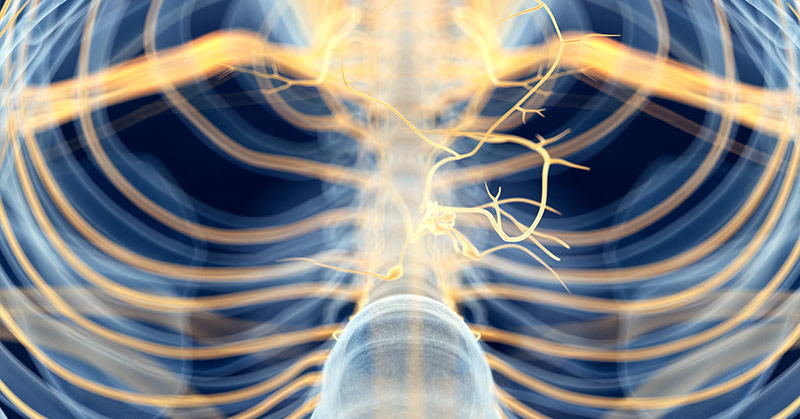When we are faced with a situation that causes extreme anxiety or fear, our body eagerly sounds the alarm for what’s known as the fight-or-flight response.
A racing heart, tense muscles, balled fists, pupil dilation, and shallow, rapid breathing aftershock. With the perception of a threat, a cascade of these physiological changes is triggered, as the central nervous system is alerted.
Your adrenal glands will then start pumping out hormones called adrenaline and noradrenaline, which have placed the body in high alert mode to either confront the threat or leave as quickly as possible. These physiological changes are not a coincidence, in fact – they serve a specific purpose:
- Rapid pulse and respiration works to increase oxygen intake for rapid or prolonged action
- The conversion of the body’s fuel source (glycogen) to fuel (glucose) allows for a burst of energy in muscles
- The dilation of the pupils is considered an evolutionary response meant to allow more light into the eye to see better at night
- The fight or flight response is reflexive, allowing us to act before thinking (such as slamming on the brakes to avoid an accident)
This superhuman-like ability was surely fantastic back when we were facing a Saber-toothed Tiger, many thousands of years ago, and this would also be helpful in escaping a near-death experience. However, how many times do we find ourselves in these dangerous situations today?
Most people are more threatened by mental and emotional threats than physical danger: a pressing deadline at work, city driving, public speaking, an argument with a loved one, or dealing with your insurance company. It’s not likely that you would fight or run in these situations, however, the issue arises when this system does not switch off.
When you are left with an increasing fight-or-flight response you’re likely to feel tense, clenched, unable to sleep and in extreme cases, you may experience chest pains and digestive issues.
Take a moment to think about how it feels to be anxious, stressed, insulted, jealous or worried. Typically people experience tightness in their chest, muscle tension, sweating, butterflies in the stomach, a feeling of impending doom and sleeplessness.
Thankfully there is a hack to turn this response off. But first, it’s important to know that we cannot coexist in both fight-or-flight and relaxation mode at the same time.
We are either in a heightened state of survival – or relaxed. The relaxation response is the opposite of fight-or-flight, and in this day and age, we should practice ways to influence the body to enter this state.
When we are in a relaxed mode, our breathing is normal, blood pressure is regulated, and our muscles are soft. In a state of relaxation, we are free from the emotional and psychological effects that tend to cloud our thinking and better judgement. When we are more objective – we also see things as they are, and are less likely to overreact.
While there are many different ways to overcome living in fight-or-flight mode, such as exercising, practicing meditation and mindfulness, supporting your adrenal glands, getting enough sleep. There is another way to suppress the fight-or-flight urges.
Long exhalations.
When someone reminds you to breathe – this is what they mean.
When you begin an inhale for a breathing cycle, your sympathetic nervous system facilitates a brief acceleration of heart rate. Whereas during exhalation, the vagus nerve secretes a transmitter substance which causes deceleration within beat-to-beat intervals.
Your vagus nerve may be the secret for counteracting a fight-or-flight response. This nerve is the longest and most complex of the 12 pairs of cranial nerves which connect the brain to the body. Your vagus nerve has a number of different functions which include:
- Sensory: From the throat, heart, lungs, and abdomen
- Special sensory: Provides taste sensation behind the tongue
- Motor: Provides movement functions for the muscles in the neck responsible for swallowing and speech
- Parasympathetic: Responsible for the digestive tract, respiration, and heart rate functioning
The vagus nerve is an essential part of the brain-gut axis and plays an important role in modulating inflammation, maintaining intestinal homeostasis, and regulating food intake, satiety, and energy homeostasis.
Vagus nerve stimulation and several meditation techniques demonstrate that modulating the vagus nerve has a therapeutic effect, mainly due to its relaxing and anti-inflammatory properties.
So if you’re looking for a simple way to promote relaxation. It’s deep breathing, with an exaggerated exhale. Follow a 4:8 ratio of four-second inhalations and eight-second exhalations.
Anytime you want to hack your vagus nerve to reduce stress or improve decision-making, remember this reading and practice some self-talk:
Say to yourself: “Hey, I’m stressing out right now. Let’s calm down so I can perform better. I’m going to take two minutes right now to do 10 rounds of vagus nerve breathing based on a 4:8 inhalation-to-exhalation ratio.”
VAGUS NERVE BREATHING
- Breathe in through your nose as you count to four
- Breathe out through pursed lips, like you’re slowly blowing out birthday candles, as you count to eight
- Use your hand to count up to five breathing cycles
- Each breathing cycle is 12 seconds:
- 5-cycles = 1-minute
- 10-cycles= 2-minutes
Your vagus nerve may just be the survival guide to combat the fight-or-flight response, and you can practice it everyday, multiple times a day.
- Longer Exhalations Are an Easy Way to Hack Your Vagus Nerve https://www.psychologytoday.com/ie/blog/the-athletes-way/201905/longer-exhalations-are-easy-way-hack-your-vagus-nerve
- A Vagus Nerve Survival Guide to Combat Fight-or-Flight Urges https://www.psychologytoday.com/ie/blog/the-athletes-way/201705/vagus-nerve-survival-guide-combat-fight-or-flight-urges
- Everything you need to know about the vagus nerve https://www.medicalnewstoday.com/articles/318128.php
- How Fear Works https://science.howstuffworks.com/life/inside-the-mind/emotions/fear2.htm
- Understanding the stress response https://www.health.harvard.edu/staying-healthy/understanding-the-stress-response
- Vagus Nerve as Modulator of the Brain–Gut Axis in Psychiatric and Inflammatory Disorders https://www.ncbi.nlm.nih.gov/pmc/articles/PMC5859128/
- Vagus Nerve as Modulator of the Brain–Gut Axis in Psychiatric and Inflammatory Disorders https://www.frontiersin.org/articles/10.3389/fpsyt.2018.00044/full

